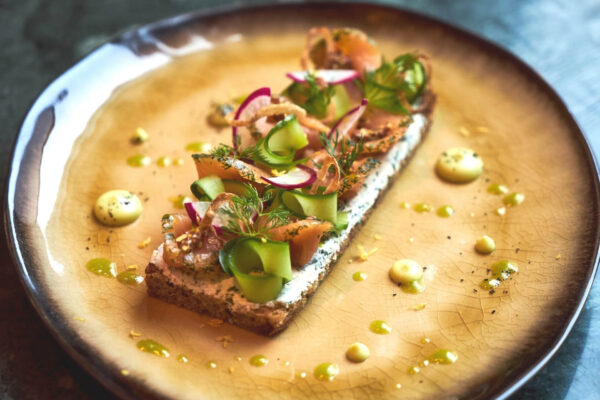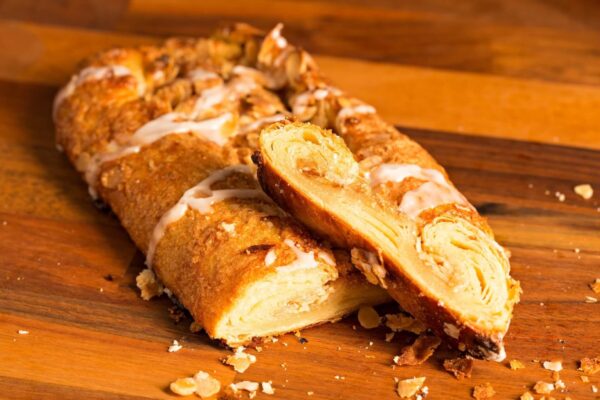Pancakes or crêpes? Neither of them – the Danish version of the pancake is called Æbleskiver. To be more precise, these are small pancake balls that are baked in a special pan. With our recipe for Æbleskiver, you can easily bring that Danish feeling into your home!
Æbleskiver – Danish pancakes Recipe
- 250 g Flour
- 1 Tsp. Baking powder
- 1 Tsp. Natron
- 1 Pinch Salt
- 1 Sachet Vanilla sugar or the extract of a vanilla pod
- 1 Pinch Cardamom
- 1 Lemon
- 4 Eggs
- 1,5 Tbsp. Sugar
- 400 ml Buttermilk
- 125 g Soft butter
- Icing sugar
- Jam
- Æbleskiver Pan
- Toothpick, roulade pin or similar
- Ingredients
- 250 g Flour
- •1 Tsp. Baking powder
- •1 Tsp. Natron
- •1 Pinch Salt
- •1 Sachet Vanilla sugar or the extract of a vanilla pod
- •1 Pinch Cardamom
- •1 Lemon
- •4 Eggs
- •1,5 Tbsp. Sugar
- •400 ml Buttermilk
First mix the flour, baking powder, natron, salt, vanilla (and a little cardamom and zest of a lemon if you like). In another bowl, beat the eggs and sugar, then add the buttermilk.
- Ingredients
- 125 g Soft butter
Then add both the flour mixture and the softened butter in spoonfuls. Leave the finished dough to rest for at least 15 minutes.
- Utils
- Æbleskiver Pan
- •Toothpick, roulade pin or similar
Then heat the pan and grease the pans with clarified butter. Fill each well about 3/4 full with batter. Once the bottom of the balls has set a little, carefully turn them over with a skewer or toothpick until they are baked all over.
- Ingredients
- Icing sugar
- • Jam
Arrange the finished Æbleskiver on a plate and dust with icing sugar. Serve with jam or fruit purée.
If you like, you can peel and finely dice an apple and mix it into the batter. Otherwise, fresh apple sauce tastes particularly delicious with it.
What are Æbleskiver? – Origin and tradition
Literally translated from Danish, Æbleskiver means “apple slices”. This is due to their presumed origin: in the Middle Ages, the last remaining apples were cut into slices in winter and then dipped in batter and fried, which is why they are also known as “Danish apple balls”.
In Denmark, Æbelskiver are a Christmas classic and can be found at every Christmas market. However, they are served all year round, as the little balls are always a tasty treat. The pancakes were first mentioned in the Danish Christmas story Peters Jul (“Peter’s Christmas”) in 1866. Those who are not familiar with them may be reminded of Dutch poffertjes, but these are usually even smaller and a little flatter.
However, Æbelskiver are related to the so-called Pförtchen or Futtjes from northern Germany. The difference? Traditionally, the North German pastries are baked with yeast and sultanas, while baking powder and vanilla are added to the batter for the Danish pancakes. They are usually without filling or have a piece of apple baked into the centre.
Another characteristic feature of Æbleskiver is the buttermilk, which makes the batter nice and fluffy. If a particularly Christmassy flavour is desired, Cardamom can be added – a very popular spice for pastries in Denmark.
The Danes prefer to eat their pancakes dusted with icing sugar. They are served with jam or, alternatively, apple sauce or plum sauce.
Baking Æbleskiver
The trick behind the round, fluffy pancake balls is the way they are baked. Traditionally, a cast iron pan, the so-called Æbleskivepande, is used. This has small semi-circular moulds that are coated with clarified butter and then filled with the batter.
It is important that the moulds are not too full, as the dough rises due to the baking powder. A dough dispenser can be particularly helpful for this, allowing you to portion the dough directly over the pan. Once the bottom of the ball has been baked, it is carefully turned over.
You don’t have a suitable pan to hand and want to bake Aebleskiver without a pan? Then you can bake the batter in muffin tins in the oven. Just note that the pancakes will be a little firmer in the oven than when fried. Otherwise, a poffertjes pan will work as well.





